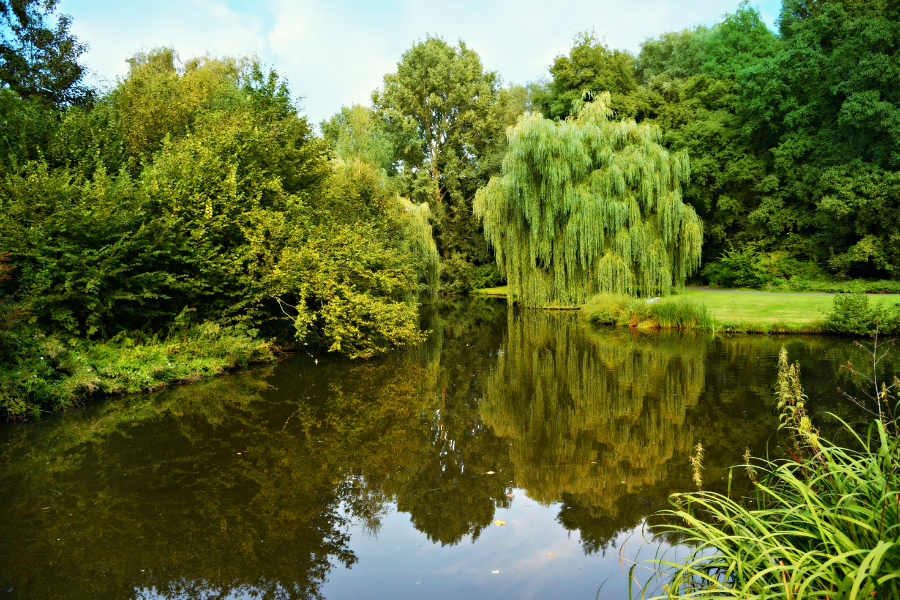Download a PDF of this One Water Spotlight.
Thinking outside the fence: A point source in Green Bay works upstream to improve water quality
“Never forget that you live at the mouth of the largest freshwater estuary in the world … and never forget the great responsibility you bear for that.”
– Dr. Jack Day, Professor Emeritus, University of Wisconsin-Green Bay, and NEW Water Commissioner
That quote hangs on the wall of the Jack Day Environmental Education Center, in homage Dr. Day, who dreamed that the waters of Green Bay would once again be swimmable and fishable.
The environmental education center bearing his name sits at the confluence of the Fox River and the Bay of Green Bay, which leads to Lake Michigan. The Great Lakes hold 84 percent of North America’s surface waters, and 21 percent of the earth’s surface freshwater. In Wisconsin, the joke goes that while Minnesota may claim to be the land of 10,000 lakes, Wisconsin has more – they just haven’t gotten around to naming them all. Nearly one-fifth of Wisconsin is covered in water, with more than 15,000 lakes, these waters have served as a keystone of the Wisconsin economy.
The Lower Green Bay and Fox River are among the major points of environmental concern, contributing an estimated one-third of the excess nutrients to Lake Michigan. As the snow melts each spring, nutrients, and sediment spills into the Bay from the Fox River, creating an anoxic, or “dead zone,” threatening the health of Lake Michigan.

After the snow melts in Wisonsin, nutrients and sediment enter the waterways. Photo credit: Steve Seilo
NEW Water, the brand of the Green Bay Metropolitan Sewerage District, is facing new permit requirements to decrease the amount of phosphorus and sediment it discharges. The District is responsible for less than three percent of the total phosphorus entering the Bay. Most of sediment and nutrients come from agricultural and residential areas.
NEW Water launched a cost-benefit analysis to determine whether to upgrade or even build a new treatment facility or look elsewhere to reduce nutrient pollution. Recognizing the challenge utilities like NEW Water face, the State of Wisconsin allows point sources to work with partners to collectively reduce the phosphorus and sediment in the watershed through an innovative approach called adaptive management. For a fraction of the cost of building a new facility, NEW Water can leverage partnerships to both meet permit requirements and improve water quality.
“As providers of an essential community service, we are tasked with balancing environmental stewardship with fiscal responsibility,” said Tom Sigmund, Executive Director of NEW Water. “Adaptive management is quickly emerging as the most cost-effective approach with the greatest environmental impact.”
In 2013, NEW Water created an Environmental Programs division and brought in veteran county land conservationist Bill Hafs as the leader. Hafs assembled a pilot project team to test the waters of this new approach and chose a 4,800-acre primarily agricultural sub-watershed area just west of Green Bay, in Silver Creek.
As providers of an essential community service, we are tasked with balancing environmental stewardship with fiscal responsibility.
Launched in 2014, the Silver Creek Project seeks to implement best management practices to improve water quality. NEW Water has established a monitoring program that will provide data to demonstrate the impact of implementing these practices on the land. By planting cover crops, installing grassed waterways, and greening up shores with buffer strips, NEW Water prevented 689 pounds of phosphorus and 2,270,000 pounds of sediment from entering area waterways. Over the past winter, 70 percent of the land was in cover crops—an increase from 30 percent at the beginning of the project. Seven percent of the crop acres have been restored to wetlands, which improves water quality and base flow. The project is achieving a range of environmental benefits beyond what the permit requires.


Grassed waterway in Silver Creek: before and after installation.
“NEW Water has created a framework for cooperation between a wastewater treatment facility and agriculture. This is an innovative way to approach conservation,” said Barry Bubolz of the Natural Resources Conservation Service. “The farmers in Silver Creek are participating in a project which will have an environmental and economic impact on Northeast Wisconsin. This teamwork approach with NEW Water and conservation agencies is demonstrating success.”

NEW Water is engaging in partnerships throughout the watershed to improve area waters. Here, NEW Water is presenting an Interseeder to help with cover crop planting.
As a part of this collaborative approach, the Oneida Tribe of Indians of Wisconsin is a key partner. In the video, “Water Knows No Boundaries,” Oneida Chairwoman Christina Danforth said, “There has to be a balance of the use of land and its impact on the streams and the waters. If we take care of the environment, the environment will take care of us. And nothing can replace that.”
Bill Hafs hopes that this project will provide a template for further adaptive management projects, and inspire other non-traditional partnerships between point and nonpoint sources. “Economics and water quality are really driving this train,” Hafs says. “It is really a multiple win: for the farmers, for NEW Water, for the ratepayers, and for the environment. The real question is, can we apply what we’ve learned, and go full scale?”
NEW Water has received project support grants from public and philanthropic sources such as the EPA’s Great Lakes Restoration Initiative, Fund for Lake Michigan, and Ducks Unlimited for the Silver Creek Project.
Partners in this effort include: the Oneida Tribe of Indians, US Fish and Wildlife Service, US Department of Agriculture’s Natural Resources Conservation Service, US Geological Survey, UW Green Bay, Brown County and Outagamie County Land and Water Conservation Departments, The Nature Conservancy, Ducks Unlimited, private agronomists, and the farmers in Silver Creek. CH2M has been retained to facilitate the project.


